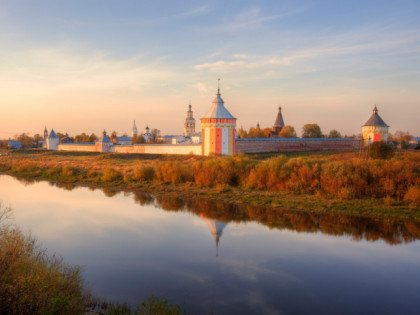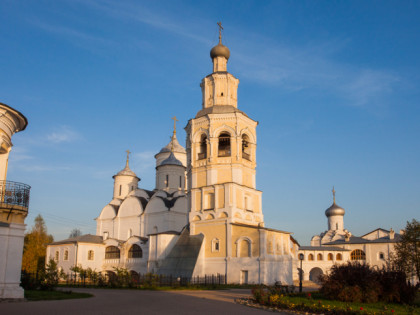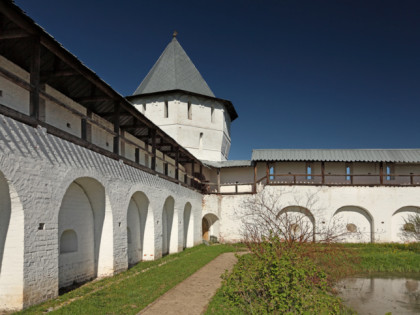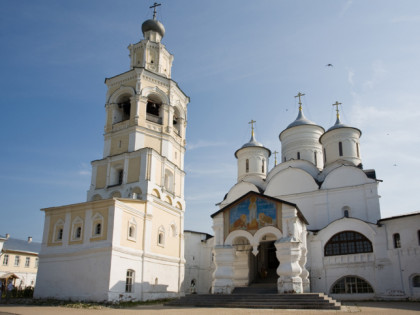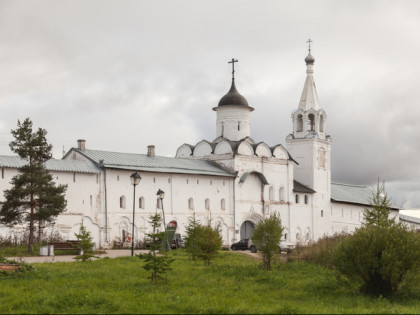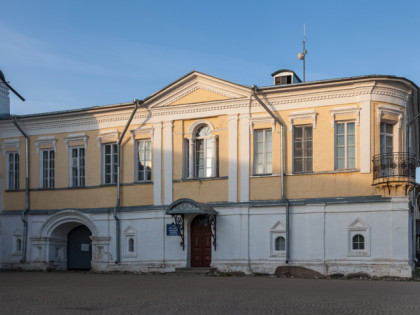Spaso-Prilutsky Monastery – the Main Monastery of the Russian North
The Spaso-Prilutsky Monastery sprang up on the Vologda River, where there passed the trade route from Moscow to Arkhangelsk. It was founded in 1371 by the Monk Dmitry Prilutsky, a disciple of Sergius of Radonezh, the founder of the Trinity Lavra of St. Sergius, the spiritual center of Russia. Thanks to the reputation of the Holy Father-founder and the strategic position, the monastery enjoyed the patronage of Russian tsars, including Ivan IV the Terrible.
The oldest surviving building of the Spaso-Prilutsky Monastery is a five-domed stone Saint Saviour Cathedral with a two-tiered gallery. It came to replace the wooden Church of the Savior in 1542. After the raids of the Poles and Lithuanians, Tatars and Cossacks in the XVII century, walls and towers were built in the monastery for protection. The monastery began to flourish thanks to the earnings from salt making. Even an orphanage and a school were opened here. However, the year 1811 turned out to be sad for the monastery: here there was a fire which destroyed all the interior decoration of the Saint Saviour Cathedral. It took a long time to restore it. In 1918 the monastery was closed. In the 1920s the Vvedensky Church housed a film club, a buffet and a theater, and in the 1930s the prisoners, heading for the Gulag, were kept here. In the 1990s monks returned to the monastery and services resumed. The wooden tent Assumption Church of the early 16th century was transferred to the Spaso-Prilutsky Monastery. Today the monastery keeps the copy of the icon of Dmitry Prilutsky, which Tsar Ivan III took to the campaign against Kazan. The original is kept in the Vologda Museum Reserve. Saint Dmitry Prilutsky and the Russian poet Konstantin Batyushkov are buried in the monastery.
GPS coordinates
59.26261258928818, 39.89028453826904
Phone
+7 817 2559861
Official website
Opening Hours
Now - closed
Mon-Sat
10:00-17:00
Sun
12:00-17:00
Nearby

Avenyu
Snack Bar • Bar • Café
+7 817 2505425
Payment methods:

Tonga
Bar
+7 8172 722322
Payment methods:

D`fler
Coffee shop • Patisserie • Café
+7 921 8209420
Payment methods:

Biblioteka
Restaurant • Hotel • Bar
+7 8172 264274

Parizhanka
Coffee shop • Patisserie • Café
+7 817 2762726
Payment methods:

Bulvar
Restaurant • Bar • Café
+7 817 2502582
Payment methods:

ArхiFud, OOO
Bistro • Snack Bar • Café
+7 817 2727838
Payment methods:

12 stulev
Tavern • Bar • Café
+7 817 2724774
Payment methods:

Church of the Intercession on the Torg
Architectural Monuments • Temples and places of worship • Cathedrals and churches • Other places

ARS
Restaurant • Bar • Café
+7 817 2720575
Payment methods:

Yaponiya
Restaurant • Sushi bar • Café • Catering
+7 817 2217000
Payment methods:

Pelmen
Snack Bar • Bar • Café
+7 8817 2502019
Payment methods:

Istoriya
Restaurant • Hotel • Bar • Café
+7 817 2723042
Payment methods:

Priluckij dvorik
Restaurant • Bistro • Bar • Café
+7 817 2559845
Payment methods:

Silver
Bar • Café
+7 817 2703453
Payment methods:

Lace Museum
Museums and Exhibitions • Other places

Sem vecherov
Restaurant • Banquet room
+7 8172 728282
Payment methods:
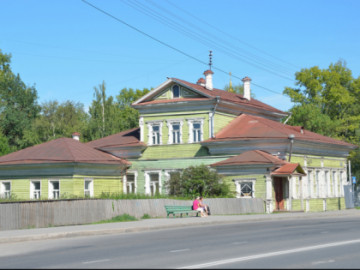
Zasetsky House
Architectural Monuments • Other places

Monblan
Restaurant • Bar • Café
+7 817 2721414
Payment methods:

Kataleya
Restaurant • Banquet room • Bar • Café
+7 817 2337070
Payment methods:

Krylya
Bar • Grill bar • Café
+7 817 2728476
Payment methods:

Polyana
Snack Bar • Bar • Café
+7 964 6648045
Payment methods:

Мясо
Restaurant • Family restaurant
+7 8172 508151
Payment methods:

Veselyj blin
Bistro • Bar • Café
+7 817 2787313
Payment methods:

Berry Bar
Restaurant • Bar • Café
+7 817 2787312
Payment methods:
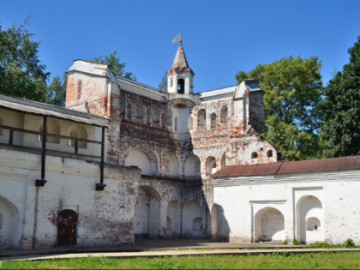
Vologda Kremlin
Architectural Monuments • Other places

Volstreet
Coffee shop • Patisserie • Café
+7 817 2581828
Payment methods:

Arbat
Restaurant • Karaoke • Bar • Café
+7 921 1275377
Payment methods:

Korica
Restaurant • Banquet room • Bar • Café
+7 817 2787788
Payment methods:

Lapsha
Restaurant • Bar • Café
+7 817 2503583
Payment methods:

Coffee Cake
Coffee shop • Bar • Café
+7 817 2581093
Payment methods:

Kioto
Restaurant • Sushi bar • Café • Catering
+7 817 2720627
Payment methods:

Drova
Family restaurant • Bar • Café
+7 817 2501077
Payment methods:

Sarvan
Restaurant • Bar • Café
+7 817 2701191
Payment methods:
